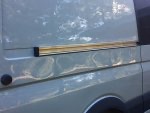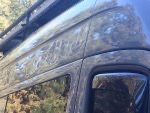Spray foam and panel warp: Is it worth it?
- Aug 7
- 3 min read
Does Spray Foam Warp the Side Panel of Vans ?
A YES! The heat generated applying the spray foam in the van causes the external van skin to warp out of shape due to the heat and foam expansion, warping the steel skin of the van out of shape leaving an uneven look to the side of the van. Modern vans have large skin panels that warp easily using spray foam.
Here’s an overview of the advantages and disadvantages of using spray foam insulation in vehicles in the UK, particularly with regard to the risk of panel warping:
Advantages of Spray Foam Insulation in Vehicles
Exceptional thermal and acoustic performance: Spray foam excels at sealing gaps, filling irregular spaces, and providing both insulation and sound deadening better than boards or fleece alternatives .
Lightweight: Typically adds minimal weight and may even be lighter than alternatives.
Moisture resistance (closed-cell foam only): Closed-cell variants form a tight seal and can prevent moisture from reaching the vehicle’s metal surfaces, reducing the risk of rust when properly applied .
Disadvantages & Risks
Panel warping (oil-canning effect): The foam’s expansion and the heat from its chemical reaction can deform thin automotive panels easily over time. This often presents as ripples or waves in the bodywork, particularly if applied unevenly or in thick layers.
Removal is nearly impossible: Once applied, spray foam is very difficult to remove cleanly. This complicates repairs, wiring changes, and future bodywork .
Hinders servicing and retrofitting: Wiring and other components need to be placed before foaming. Any later modifications become a major challenge.
Value: Often buyers are adverse to buying a vehicle which has been foamed due to its permanent nature.
Installation risks:
Messy application: DIY kits can misfire, cause drips, or cure poorly
Health hazards: Uncured foam emits volatile isocyanates and other irritants. Proper ventilation and protective gear are essential during installation .
Environmental and long-term concerns: Spray foam contributes microplastics and may be less sustainable.
What About Panel Warp? This is the big one.
Panel warp is one of the most commonly cited risks. According to users:
“Thin layers is the key, thick layers can cause the skin of the van to wrinkle.”
“The outer skin … is … so pathetically thin … so you end up with waves or ripples.”
Even professionals advise caution. The reaction heat during curing not just physical expansion can warp panels, especially if applied without control.
Is It Worth It for Avoiding Warp?
Spray foam can be highly effective but whether it’s “worth it” depends on your priorities:
Pros & cons
Excellent thermal/acoustic insulation
Risk of metal panel deformation
Lightweight and gap-filling
Permanent and difficult to remove
Moisture-resistant (closed-cell) if done right
Requires precise, low-layer application to avoid warp
Potentially environmentally unfriendly if misused
Health risks during installation
If you need top-tier insulation and commit to professional, thin-layer application, spray foam may be beneficial. However, if ease of serviceability, flexibility, or avoidance of panel distortion are priorities, alternatives like Thinsulate, wool, or rigid foam boards often offer a safer balance .
Final Recommendation
Spray foam insulation can be effective, but the risk of warping, difficulty of removal, and complexity of proper application make it a gamble especially if you’re not certain you want to avoid future repairs or modifications. Often body shops will not touch a vehicle without specialist training or knowledge of the vehicle, especially if any repairs which require welds or cuts are needed.
If avoiding panel warp is your key concern, safer, cleaner alternatives might serve just as well, especially in a UK vehicle climate where serviceability and durability are paramount and so many automotive material are available and designed to be used in a Campervan or leisure vehicle.









Comments